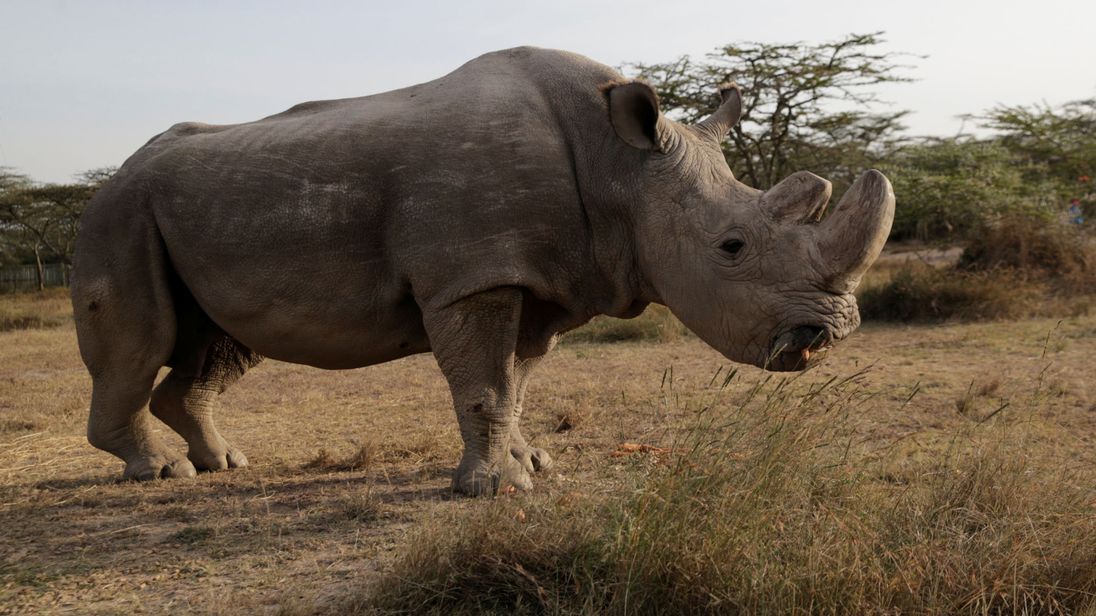The last white rhino
March 21, 2018 | Expert Insights

Sudan, the last male northern rhinoceros in the world has passed away. This has triggered a heated debate regarding the role played by human beings in the extinction of various species.
Background
The white rhinoceros or square-lipped rhinoceros (Ceratotherium simum) is the largest extant species of rhinoceros. It has a wide mouth used for grazing and is the most social of all rhino species. There are two subspecies within the white rhinoceros family – the southern white rhinoceros and the northern white rhinoceros. The southern white rhinoceros has an estimated population of 19,000 - 21,000. These estimates are based on data from 2015. The northern white rhinoceros are far more rare. In fact, by 2018, it has been confirmed that there are only two remaining northern white rhinoceros left in the world. Rhinos are targeted by poachers fueled by the belief in Asia that the horns cure various ailments.
The white rhinoceros are among the many endangered species in the world. Scientists have stated that some of the species have gone extinct due to human initiated actions. Nearly 20,000 species of plants and animals are at a high risk of extinction. "Unlike past mass extinctions, caused by events like asteroid strikes, volcanic eruptions and natural climate shifts, the current crisis is almost entirely caused by us -- humans," explains the Center for Biological Diversity. "In fact, 99 percent of currently threatened species are at risk from human activities, primarily those driving habitat loss, introduction of exotic species and global warming."
Analysis
Sudan, the last known male white rhinoceros has passed away. He had been kept protected in a massive enclosure in Kenya. A few years ago, an image of him being guarded by armed men went viral across the world. He needed round-the-clock protection to keep his safe from poachers. He was 45 years old – which makes him an elderly animal.
Ol Pejeta Conservancy confirmed his death through a tweet noting, “It is with great sadness that Ol Pejeta Conservancy and the Dvůr Králové Zoo announce that Sudan, the world’s last male northern white rhino, age 45, died at Ol Pejeta Conservancy in Kenya on March 19th, 2018 (yesterday).” He had passed away due to age related symptoms and had to be euthanized as he was in great amount of pain. In a later statement, the organization said, “Once his condition worsened significantly and he was unable to stand up and evidently, suffered a great deal, the decision to euthanize him was made by his veterinary team.”
He was the last of his kind but the species itself is not extinct. He is survived by his daughter (25 years old) and his grand daughter (17 years old). Scientists have said that through IVF and other scientific treatment, they are hoping to increase the population of the northern white rhinoceros.
In Kenya Paula Kahumbu, Director of the Wildlife Direct charity, said the news of Sudan’s death had hit people hard. “The outpouring of grief from Kenyans, especially the younger generation, who woke up to hear that Sudan was dead this morning is a powerful reminder that we must never allow this to happen again. We did not do enough to save this majestic species. Now we must stand up and demand action – take action – to prevent the same thing happening to cheetah, elephants, black rhinos, giraffes – we must take ownership of this as Africans and educate people.”
A paper published in a recent special issue of the journal Science noted that human initiated activity has resulted in 322 animal extinctions over the past 500 years. The paper also revealed that two-thirds of these extinctions occurred in the last two centuries. "Indeed, if current rates (of human population growth) were to continue unchecked, population size would be, by 2100, about 27 billion persons -- clearly an unthinkable and unsustainable option," co-author Rodolfo Dirzo, professor of environmental sciences at Stanford University, told Discovery News.
Assessment
Our assessment is that rapid urbanization along with fast depletion of forest cover around the world has had a tremendously negative impact on wildlife population. It has also resulted in a number of other problems such as global warming. The death of Sudan is an indication that the fate of many majestic beings across the world is at stake and that must be addressed. Governments across the world need to make wildlife conservation a top priority besfore it is too late.








Comments